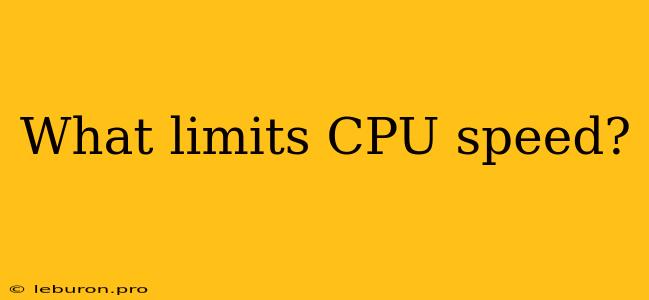The speed at which a CPU can process instructions is a fundamental factor in determining the overall performance of a computer system. While advancements in semiconductor technology have led to exponential increases in CPU clock speeds over the years, there are inherent limitations that prevent CPUs from running arbitrarily fast. Understanding these CPU speed limitations is crucial for comprehending the complexities of computer architecture and the ongoing pursuit of faster and more efficient processors.
The Fundamental Limits of CPU Speed
The pursuit of faster CPUs has been a driving force in the evolution of computing. However, several fundamental factors impose limitations on how fast a CPU can operate.
1. The Speed of Light
The speed of light represents an ultimate physical limit on how quickly information can travel. Signals within a CPU must traverse physical distances, and even at the speed of light, there is a finite time delay. While modern CPUs are designed to minimize these delays, the speed of light remains an inescapable constraint.
2. Heat Dissipation
As CPUs operate at higher speeds, they generate more heat. This heat can cause components to overheat and potentially damage the processor. To mitigate this problem, CPUs are equipped with cooling mechanisms like heat sinks and fans, but the amount of heat that can be dissipated effectively remains a limitation.
3. Power Consumption
Higher CPU speeds require more power to operate. This increased power consumption can lead to inefficiencies and may exceed the power budget of a system. Moreover, excessive power consumption can further contribute to heat generation, creating a vicious cycle.
4. Clock Cycle Time
The clock cycle time of a CPU determines how frequently it can execute instructions. While advances in manufacturing techniques have allowed clock speeds to increase dramatically, there are practical limits to how fast a clock can be run. A faster clock speed requires the CPU to perform operations in a shorter time, which can lead to increased power consumption and heat generation.
Architectural Limitations
Beyond the fundamental limits, the architecture of a CPU itself also plays a crucial role in determining its speed.
1. Pipelining
Pipelining is a technique used to improve CPU performance by breaking down instructions into smaller stages and executing them concurrently. While pipelining can significantly increase throughput, it also introduces dependencies between instructions, potentially limiting the overall speed.
2. Branch Prediction
Branch prediction is a technique used to anticipate the outcome of conditional instructions, allowing the CPU to execute instructions speculatively. However, incorrect predictions can lead to performance penalties, and the effectiveness of branch prediction techniques can vary depending on the nature of the code being executed.
3. Cache Hierarchy
A cache hierarchy is used to store frequently accessed data closer to the CPU, reducing the need to access slower main memory. While caching can significantly improve performance, the size and organization of the cache hierarchy can impact CPU speed. A large cache can improve performance but also increases cost and complexity.
4. Instruction Set Architecture (ISA)
The instruction set architecture of a CPU defines the set of instructions it can understand and execute. A complex ISA can provide more flexibility but may also lead to slower execution speeds due to the complexity of decoding instructions.
The Future of CPU Speed
Despite the inherent limitations, continuous advancements in semiconductor technology and computer architecture continue to push the boundaries of CPU speed. New materials, advanced fabrication techniques, and innovative architectural designs are being explored to overcome these challenges.
One promising approach is the development of multi-core processors, which utilize multiple processing cores to achieve higher performance. Another area of active research is the development of neuromorphic processors, which are inspired by the structure and function of the human brain.
However, it is important to note that increasing CPU speed is not always the most effective way to improve performance. In many cases, optimizing software and algorithms can yield significant gains in efficiency and throughput. The future of computing likely involves a combination of hardware and software optimizations to meet the ever-increasing demands for performance.
Conclusion
The speed of a CPU is a complex and multifaceted concept that is influenced by a variety of factors. While technological advancements have enabled dramatic increases in CPU speeds over the years, there are fundamental limitations that prevent CPUs from running arbitrarily fast. The speed of light, heat dissipation, power consumption, and architectural limitations all play a significant role in determining the upper bound of CPU speed.
Understanding these limitations is crucial for appreciating the challenges faced by computer architects and the ongoing pursuit of faster and more efficient processors. As technology continues to evolve, we can expect to see further advancements in CPU speed, but these advancements will likely be accompanied by innovations in other areas, such as software optimization and parallel processing, to achieve optimal performance.
